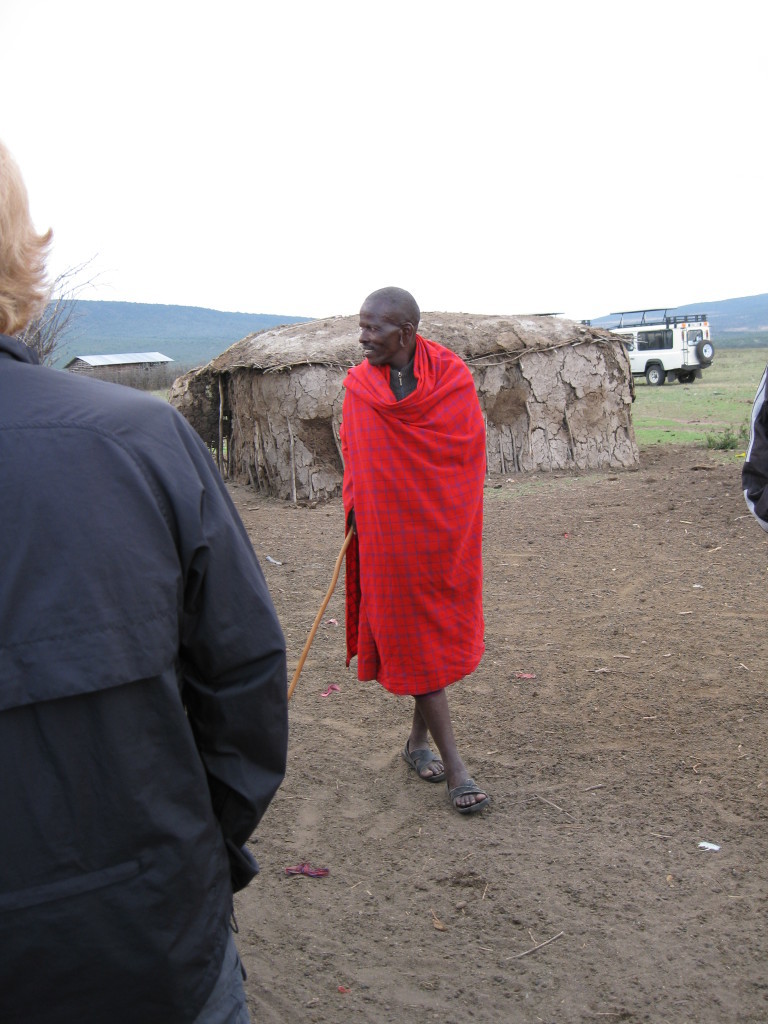On Safari in Tanzania Part 5 – Visiting a Maasai Boma (Village)

The Boma
Part of our culture shock was a visit to a Maasai Boma or small village of a few mud huts. The village population consisted of two husbands, seven wives and about forty children. There were many paradoxes for us to grapple with such as the extreme poverty, lack of education and health care, polygamy, lack of hygiene facilities, animals everywhere and dirty water gathered every day several miles from the village in barrels on the backs of burros. The government is now beginning visits for immunizations and has started some rural schools. Most families will send only one of their many children to school as the rest are needed for herding and other chores. Its a start, they say.
At the same time we were impressed with the gentleness of all the people, the respectfulness of the children and their happiness. We were dismayed by their runny noses and ring worm skin evidence but we envied the teamwork we saw among both adults (mostly the women) and children. Village life is both simple and vital for survival. The Maasai live off the land herding cattle and goats, not eating them but using their milk to make cheese. They sell or barter animals to get basic necessities such as cloth to make colorful clothing, rice and other staples. The number of cattle and goats they own is the measure of their wealth.
While we were standing in the middle of the village we heard a cell phone ring. We all looked at each other in disbelief that any of us could be so attached to the other end of any outside calls that they couldn’t wait at least for a private time or, even better, until the safari was over. What we didn’t know was that the Tanzanian government provides a free cell phone to the village leader to be able to maintain emergency or other important communication capability. The village chief reached inside his outer wrap and pulled out a cell phone and conversed in Swahili as if this were a routine occurrence. The chief does have to walk five miles each way to the larger town that has electricity to recharge the battery! This is him in the photo. A typical family dwelling made of wood and dried cattle dung is visible behind him.
Ironically, I felt envious of them for the apparent peacefulness and contentment (or maybe acceptance) of their circumstances. We 21st century Americans never seem content with our circumstances whether they are political, economic, or social. I am not ready to trade my modest homestead for one of theirs, however!
I’m going to show a slide show and a short video to give you some of the flavor of this visit. After this, I’ll shift to the next morning’s return visit for the specific purpose of shopping at the village Co-op Marketplace where crafts made mostly by the women are displayed and sold to tourists like us to add some small amounts to the tiny cash incomes of these people.
Take a look at a small fraction of what we saw.
[slideshow_deploy id=’4356′]
Click the link for a short video.
https://www.youtube.com/watch?v=jiKQ3LhGl_w
The Co-op Marketplace
After our experience in the Maasai village we returned to our camp for supper and lots of discussion of what we had seen and some of the implications of life for these people.
For example, we wondered how the Tanzanian government and even the United Nations fit into life in the Bomas.
We learned that the government has very little revenue because of the overall lack of wealth in the country that could conceivably be taxed for any kind of improvement in the quality of life anywhere in the country. There is some outside financial aid trickling into the country and that has enabled some rudimentary health care in the bush, mainly child immunizations that have dramatically reduced the rate of infant mortality. There is also some school building and staffing beginning to take place. We saw one new school consisting of four classrooms and a tiny cabin for the teacher. The families in the bush don’t see the value of education since they cannot imagine life any different from the herding and Boma life they have known all their lives. When pressed to send their children they usually send one child for a less than adequate amount of time and then send another in its place – not a very satisfactory way to educate!
When we awoke the next morning we packed up our belongings in preparation for a journey southward to our second campsite at the edge of the Serengeti National Park.
Before leaving the Wasso area, we returned to the Maasai Boma to see and participate in a Co-op Marketplace of crafts made mostly by the women of several Bomas over a several mile area. This regional marketplace is still under construction and further expansion is hoped to bring more tourists and more crafts which will help to add some cash to the tiny incomes of these people.
Take a look at the slide show and video and see what we saw.
[slideshow_deploy id=’4387′]
As you look at the video below and think about the words and sights you and we have seen, imagine how much different your life would be if you lived in a Boma. We all did and we admired these peaceful, friendly,industrious people, but none of us were ready to trade places with them!
Click the link to see the short marketplace video.
http://www.youtube.com/watch?v=ckKwwahpmyA






